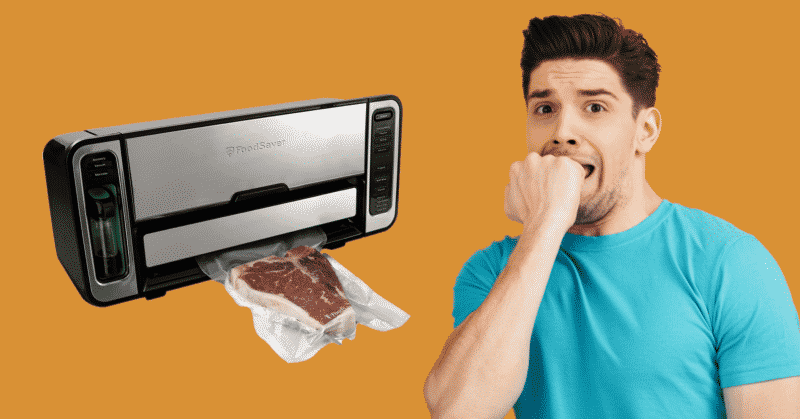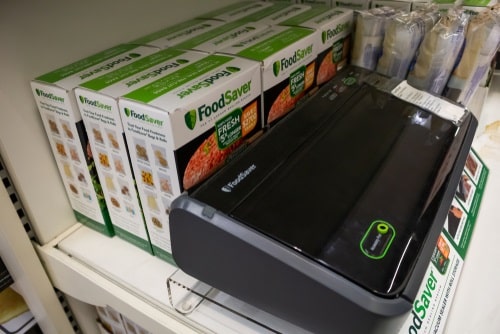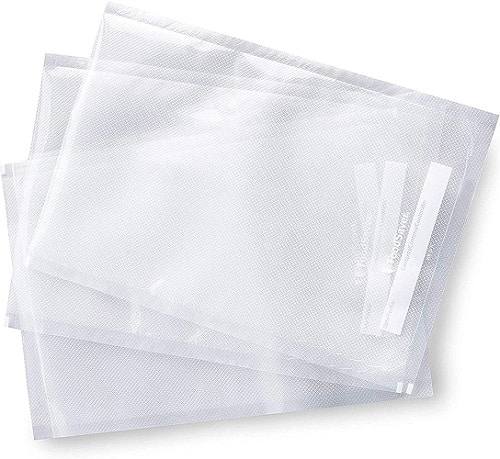
The FoodSaver is a handy kitchen appliance that increases the longevity of your perishable foods by five times.
A lot of food bacteria and microorganisms need oxygen to stay active. Temperatures lower than 40°F deactivate bacteria, similarly sucking the oxygen from the environment.
FoodSaver is simply a vacuum sealing machine, which can suck the air out of a plastic bag and seal it to provide a perfect environment for your food without any oxygen for the bacteria to thrive in.
The no oxygen environment not only protects your food from bacteria but also helps retain maximum moisture and keeps your food from getting freezer burns.
The FoodSaver Vacuum Sealer is a blessing when it works, but sometimes it can become a bit problematic for you to deal with when it doesn’t.

Most people swear by the FoodSaver Vacuum Sealer as it dramatically prolongs the life of their food and makes it easy for them to correctly store their food properly.
Even when meat is stored in a freezer for longer periods of time, it is prone to developing bacteria once you take it out.
But, if you keep the meat sealed in a vacuum, the growth of bacteria will be dramatically slowed down, which is one of the core purposes of using the FoodSaver.
However, your FoodSaver may stop working as it does for so many other people. Upon inserting the vacuum bag, the FoodSaver starts its sealing process.
But instead of sucking the air and sealing the bag, the FoodSaver keeps on sucking until you manually hit the seal button. And as a result, there is still some air left inside the bag.
The entire process is automated anyway, so you shouldn’t have to worry about manually stopping the vacuum sealer.
If it’s not sealing automatically after sucking out all the air, there’s something wrong. Here’s what you can do to fix the problem.
Troubleshooting FoodSaver Won’t Stop Vacuuming
Now, we will detail a few ways to troubleshoot this issue. If your FoodSaver won’t stop vacuuming, these are the steps that you need to follow.
1. Make sure the bag opening is completely dry

If the open part of your vacuum bag is not completely dry, the vacuum sealer will keep on sucking until it registers no moisture inside the bag.
If the drip tray is full, the FoodSaver won’t be able to suck the water inside its drip tray. As a result, you will see your FoodSaver continue in an infinite vacuum cycle. That’s not something you want.
Take a cotton cloth and dry off any excess moisture from the bag’s opening.
Also, check the FoodSavers’ drip tray to make sure it’s not full. These may seem like simple fixes, but sometimes, the most obvious fix is the simplest.
Before you decide to implement any other fix, it’s recommended that you check whether there’s no moisture in the bag and the drip tray has been recently emptied.
Once you are done, you can then try to see if the vacuum sealer works or not.
2. The accessory hose
Some FoodSaver vacuum sealers come with a detachable accessory hose.
The FoodSavers’ accessory hose has to be detached before using the main vacuum sealer for sealing.
Not doing so may affect how your vacuum sealer operates, and sometimes it might keep on vacuuming without sealing.
Just remove the accessory hose and then check if it works or not. If it doesn’t do the trick, move on to the next solution.
3. Replace the gasket
Your FoodSaver has a silicone ring installed inside. This silicone ring (gasket) is what allows your FoodSaver Vacuum Sealer to form a proper vacuum seal on any bag.
According to the company, its products’ gasket has a 1-year working life. After which you should replace the gasket with a new one.
Sometimes a damaged gasket may cause your FoodSaver to have a continuous vacuuming error.
If there’s a leak in the gasket, it’s obviously not going to seal properly. Air will continue to pass through, and it just won’t give you the desired result.
4. Sealing bag with no imperfections
We all like to reuse our things if possible. Before reusing a zipper bag for vacuum sealing, make sure the bag has no tears or imperfections.
A slight tear at any location might cause a continuous vacuuming error as well. The air will continue to escape, and this is going to result in a serious problem.
The FoodSaver will not acknowledge the tear, and it will continue trying to suck it out. If you are going to reuse the bags, it’s recommended that you keep them in a safe spot.
Don’t crumple the bags before you keep them in a drawer. Keep them in a tray if possible, and use them whenever you have to.
Examine the bags to determine whether there’s something wrong with them before you insert them in the FoodSaver.

5. Proper insertion
Whenever you’re placing the plastic bag inside the FoodSaver vacuum sealer, make sure the plastic bag is properly inserted into the mouth of the vacuum.
Having even a little bit of the bag outside can cause a continuous vacuuming error.
You may want to double-check the bag or follow the instructions manual’s instructions to determine if it is inserted properly.
However, if none of the tips given in this article help resolve the problem, you may want to take the appliance to a repair technician. The issue might be caused by a faulty moisture sensor or something else.
It’s best to take it to a repair expert instead of tinkering with the FoodSaver on your own. They will charge a nominal fee and fix it for you, provided it’s not broken beyond repair.